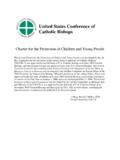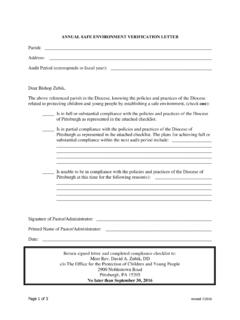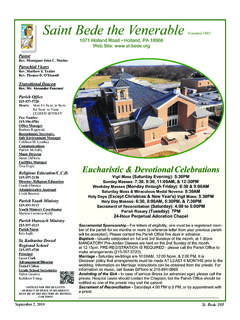Transcription of CONSULTATION DRAFT - cpsltd.org.au
1 National Catholic Safeguarding Standards APRIL 2018 C O N S U L T A T I O N D R A F T Catholic Professional Standards Ltd 2018 Contact us Enquiries regarding use of this document are welcome at: Catholic Professional Standards Ltd GPO Box 5110 Melbourne, Vic, 3001 Email: Catholic Professional Standards Ltd i Contents Preamble 1 An initial focus on children 1 The application of the Standards 2 Standard One .. Committed leadership, governance and culture 5 Standard Two .. Children are safe, informed and participate 8 Standard Three.
2 Partnering with families, carers and communities 11 Standard Four .. Equity is promoted and diversity is respected 13 Standard Five .. Robust human resource management 14 Standard Six .. Effective complaints management 18 Standard Seven .. Ongoing education and training 20 Standard Eight .. Safe physical and online environments 22 Standard Nine .. Policies and procedures support child safety 24 Standard Ten .. Regular improvement 26 Glossary 27 Catholic Professional Standards Ltd 1 Preamble Catholic Professional Standards Ltd (CPSL) is committed to fostering a culture of safety and care for children and vulnerable adults within the Catholic Church in Australia.
3 We have developed the National Catholic Safeguarding Standards. CPSL will audit compliance with these Standards. It will hold accountable the leaders and members of Catholic Church entities and organisations for the safety of children and vulnerable adults who come into contact with the Church and its works. This includes Catholic dioceses, congregations and institutions providing education, health and aged care, social and community services, pastoral care and other services. CPSL will publicly report audit findings. CPSL will also provide education and training with respect to the Safeguarding Standards.
4 The values underpinning CPSL s approach to safeguarding children and vulnerable adults include the inherent dignity of each person. This is at the heart of Gospel teachings. All people, especially children and the vulnerable, have an absolute right to be safe and free from all forms of harm including physical, sexual and psychological harm, neglect and exploitation. An initial focus on children The first phase of the National Catholic Safeguarding Standards focuses on requirements for Catholic Church entities and organisations to safeguard children.
5 Development of requirements for the safeguarding of vulnerable adults will commence in 2019. The National Catholic Safeguarding Standards set out ten Standards, providing the framework for Catholic Church entities and organisations to build child-safe cultures and to advance the safety of children across the Catholic Church. The Standards take into account the guidance of the Royal Commission into Institutional Responses to Child Sexual Abuse and the National Statement of Principles for Child Safe Organisations from the Australian Human Rights Commission ( DRAFT ).
6 The underlying principles of a child safe organisation include: creating an environment where children s safety and wellbeing are at the centre of thought, values and actions; understanding the nature of abuse and risk factors; placing emphasis on genuine engagement with, and valuing of, children and young people; creating conditions that reduce the likelihood of harm to children and young people; creating conditions that increase the likelihood of identifying any harm; and responding appropriately to any concerns, disclosures, allegations or suspicions of harm.
7 Catholic Professional Standards Ltd 2 The National Catholic Safeguarding Standards are designed to ensure Catholic Church entities have a child safe culture and practices that are in accordance with legislative requirements, the Australian community s expectations and Gospel values. The Standards will be implemented by all Church entities to promote a more comprehensive and consistent approach within the Australian Church. These Standards are designed to be applied to all Church ministries in every state and territory of Australia. Every child must be protected by the same rigorous standards.
8 These Standards apply regardless of where the children live or what part of the Church they encounter, be it their local parish, a Catholic school, welfare or health service, a youth group, a camp, a sacramental program or any one of the many other Catholic services and activities that reach into the community. Due to the different nature, size and characteristics of Church entities, the risk of harm to children will vary. Therefore, it is incumbent on each Church entity to consider every one of the 10 Safeguarding Standards. Each Church entity must take time to identify risks that may arise in their particular context and develop ways to mitigate or manage these risks.
9 The safeguarding of Aboriginal and Torres Strait Islander children, children from culturally and/or linguistically diverse backgrounds and children with a disability requires particular attention, as these groups of children are more vulnerable to abuse. The application of the Standards The successful application of these Standards requires the commitment of all leaders within Church entities. Church leaders must actively champion and model these Standards. The Standards provide a framework and mandate for leaders to ensure that systems and processes within their entity or organisation promote the safeguarding of children.
10 All activities and ministries under the jurisdiction of a Church Authority are covered by these Standards including where a Church Authority has canonical responsibility for locations outside of Australia. All the standards are of equal importance and are inter-related. They need to be read collectively, not in isolation, as there are necessary overlaps. Requirements within one Standard may be similar, complementary, relevant and/or inter-related to another Standard. Catholic Professional Standards Ltd 3 The National Catholic Safeguarding Standards are: Committed leadership, governance and culture The leadership and governance arrangements of Church entities promote an inclusive, welcoming environment for children and provide the foundation for transparent, accountable and risk-based approaches to ensure child safety.




